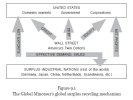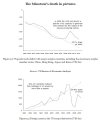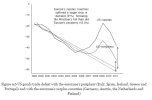I'd like to bring up another aspect of this whole spectacle - the economic situation. I'm not sure I understand all this correctly, so fwiw.
Yanis Varoufakis, in his book
The Global Minotaur, argues that the US deliberately set up the world economic system in a certain way, which he calls the 'Global Minotaur'. The two horns of the creature symbolize the US's twin deficit, i.e. the gigantic trade deficit and the gigantic debt, which both have risen most dramatically since the 70's.
Here you can see the ever-rising US debt ceiling:
And here the trade deficit, i.e. the fact that the US is importing way more goods than it is exporting:
According to Varoufakis, the system worked like this: The surplus (exporting) countries of the world (China, Germany, Japan etc.) need the US as a huge market for their products. This is the reason they invest most of their profits in Wall Street, which could re-invest this capital in the US, again leading to demand for foreign goods, thus closing the cycle (see attachment). However, Wall Street started creating imaginary 'private money' in the form of CDO's and such and thus guaranteed high returns and ever-growing US demand for products, but also built its own demise into the system.
However, Varoufakis says that this mechanism, the Global Minotaur, suffered a serious blow during the financial crisis, and is kicking and screaming ever since. V. thinks it is actually dead now and offers some arguments for this hypothesis, namely that the US lost a large amount of its capacity to generate demand for the products of the exporting nations, and that non-US residents significantly reduced their investments in US assets (see attached pictures).
Here's the hypothesis in Varoufaki's own words:
The Global Minotaur said:
The Global Minotaur Hypothesis: a summary
Since the 1970s, the United States began absorbing a large portion of the rest of the world’s surplus industrial products. America’s net imports were, naturally, the net exports of surplus countries like Germany, Japan and China; their main source of demand. In turn, the profits earned by the surplus nations’ entrepreneurs were returned, daily, to Wall Street, in search of a higher pay-off. Wall Street would then use this influx of foreign capital for three purposes: (a) to provide credit to American consumers, (b) as direct investment into US corporations and, of course, (c) to buy US Treasury Bills (i.e. to fund American government deficits).
Central to this global surplus recycling mechanism (GSRM), which I have likened to a Global Minotaur, were the two gargantuan deficits of the United States: the trade deficit and the federal government budget deficit. Without them, the book argues, the global circular flow of goods and capital (see diagram below) would not have ‘closed’, destabilizing the global economy.
This recycling system broke down because Wall Street took advantage of its central position in it to build colossal pyramids of private money on the back of the net profits flowing into the United States from the rest of the world. The process of private money minting by Wall Street’s banks, also known as financialisation, added much energy to the recycling scheme, as it oozed oodles of new financial vitality, thus fuelling an ever-accelerating level of demand within the United States, in Europe (whose banks soon jumped onto the private money-minting bandwagon) and Asia. Alas, it also brought about its demise.
...
When, in the fall of 2008, Wall Street’s pyramids of private money auto-combusted, and turned into ashes, Wall Street’s capacity to continue ‘closing’ the global recycling loop vanished. America’s banking sector could no longer harness the United States’ twin (trade and budget) deficits for the purposes of financing enough demand within America to keep the net exports of the rest of the world going (a financing process that, until the autumn of 2008, tapped the rest of the world’s surplus profits which these net exports produced). From that dark moment onwards, the world economy would find it impossible to regain its poise – at least not without an alternative global surplus recycling mechanism that replaces the wounded Global Minotaur.
This was, in brief, the central hypothesis of the book’s first edition.
In other words, the US-controlled global recycling mechanism is dead, which may be part of the reason for the worldwide economic turmoil. This also sheds some light on the developments surrounding BRICS I think: for example, China desperately needs to get access to new markets for their products, most notably the emerging markets. Also, it would be very important for exporting countries like Germany to replace US demand with new markets (such as Russia), but this is obviously not in the US' interest. Varoufakis was skeptical if the emerging countries will be able to establish a new recycling system (replacing the US Global Minotaur), but maybe what we are witnessing with BRICS is exactly this: a new world economic system, established out of sheer need because the old system died (and most countries were probably fed up anyway with the US empire).
So what does it have to do with the US elections? I think we should keep in mind that the whole US economic system is a house of cards, a ponzi scheme as it were, which is dying. If Varoufakis is right, then all it needs is a little flame to set the whole thing on fire. How will the markets react if Trump gets elected? Will it cause the 'big crash'? What will the highest PTB do - let the whole thing burn and descent into overt fascism? Was the plan to let the US take the whole world with it? Maybe BRICS can establish something like a new equilibrium, at least partially, before that happens - kind of like in the article Joe wrote:
Russian Actions in Syria Part of Radical Remaking of Global Order: A New World Awaits?
Here is another bit from the book relating to Europe, which might be another piece of the puzzle, especially regarding Germany's position:
The Global Minotaur said:
Interestingly, one of the great secrets of the post-2008 period is that the Minotaur’s death adversely affected aggregate demand in the eurozone’s surplus countries (Germany, the Netherlands, Austria and Finland) more than it did the deficit member states (like Italy, Spain, Ireland, Portugal and Greece) – see Figure 9.6. While the sudden withdrawal of capital from the deficit countries brought about their insolvency, countries like Germany saw their ‘fundamentals’ more grievously affected by the Crash of 2008. [That is, Germany really needs to get access to new markets, an orientation towards the east and the emerging markets would make a lot of sense] This fact, in conjunction with the terrible squeeze on German wages (discussed in the previous chapter), explains the deeper causes of the animosity in places like Germany that so very easily translates into anger against the Greeks and assorted Mediterraneans – feelings that are then reciprocated, thus giving the wheel of intra-European animosities another spin, favouring the rise of xenophobia, even Nazism [meaning: the crash and the change in global economic affairs can easily be blamed on weaker countries, foreigners etc. - a great tool for the PTB to create fascism 2.0?] (in countries like Greece quite incredibly), and thus leading to a wholesale readiness to push all the yellow, as opposed to the red, buttons in sight.
So yes, a dire economic situation for the US and the world, which can easily be blamed on Muslims and what have you à la Trump. Fascism on the rise like in the 30's after the crash. Making America great again? No way it seems.
Anyway, these are a few thoughts.







